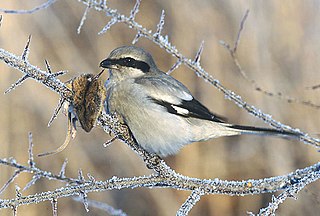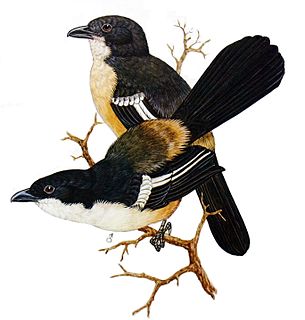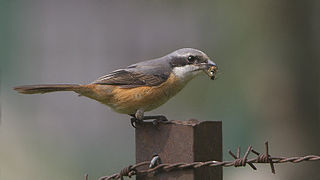
Shrikes are carnivorous passerine birds of the family Laniidae. The family is composed of 33 species in four genera.

The great grey shrike is a large songbird species in the shrike family (Laniidae). It forms a superspecies with its parapatric southern relatives, the Iberian grey shrike, the Chinese grey shrike and the American loggerhead shrike. Males and females are similar in plumage, pearly grey above with a black eye-mask and white underparts.

The woodchat shrike is a member of the shrike family Laniidae. The genus name, Lanius, is derived from the Latin word for "butcher", and some shrikes are also known as "butcher birds" because of their feeding habits. The specific senator is Latin for "senator", so-named because its chestnut cap recalled the colour of the stripe on the toga of a Roman senator. The common name "Woodchat" is an Anglicisation of German waldkatze, literally "woodcat", and "shrike" is from Old English scríc, "shriek", referring to the shrill call.

The lesser grey shrike is a member of the shrike family Laniidae. It breeds in South and Central Europe and western Asia in the summer and migrates to winter quarters in southern Africa in the early autumn, returning in spring. It is a scarce vagrant to western Europe, including Great Britain, usually as a spring or autumn erratic.

The long-tailed shrike or rufous-backed shrike is a member of the bird family Laniidae, the shrikes. They are found widely distributed across Asia and there are variations in plumage across the range. The species ranges across much of Asia, both on the mainland and the eastern archipelagos. The eastern or Himalayan subspecies, L. s. tricolor, is sometimes called the black-headed shrike. Although there are considerable differences in plumage among the subspecies, they all have a long and narrow black tail, have a black mask and forehead, rufous rump and flanks and a small white patch on the shoulder. It is considered to form a superspecies with the grey-backed shrike which breeds on the Tibetan Plateau.

The loggerhead shrike is a passerine bird in the family Laniidae. It is one of two members of the shrike family endemic to North America; the related northern shrike occurs north of its range. It is nicknamed the butcherbird after its carnivorous tendencies, as it consumes prey such as amphibians, insects, lizards, small mammals and small birds, and some prey end up displayed and stored at a site, for example in a tree. Due to its small size and weak talons, this predatory bird relies on impaling its prey upon thorns or barbed wire for facilitated consumption. The numbers of loggerhead shrike have significantly decreased in recent years, especially in Midwestern, New England and Mid-Atlantic areas.

The brown shrike is a bird in the shrike family that is found mainly in Asia. It is closely related to the red-backed shrike and isabelline shrike. The genus name, Lanius, is derived from the Latin word for "butcher", and some shrikes are also known as "butcher birds" because of their feeding habits. The specific cristatus is Latin for "crested", used in a broader sense than in English. The common English name "shrike" is from Old English scríc, "shriek", referring to the shrill call.

The rufous-tailed scrub robin is a medium-sized member of the family Muscicapidae. Other common names include the rufous scrub robin, rufous bush chat, rufous bush robin and the rufous warbler. It breeds around the Mediterranean and east to Pakistan. It also breeds south of the Sahara from the Sahel region east to Somalia; these African birds are sometimes considered to be a separate species, the African scrub robin. It is partially migratory, wintering in Africa and India. This is a very rare visitor to northern Europe.

The masked shrike is a bird in the shrike family, Laniidae. It breeds in southeastern Europe and at the eastern end of the Mediterranean, with a separate population in eastern Iraq and western Iran. It is migratory, wintering mainly in northeast Africa. Although it is a short-range migrant, vagrants have occurred widely elsewhere, including northern and western Europe. It is the smallest member of its genus, long-tailed and with a hooked bill. The male has mainly black upperparts, with white on its crown, forehead and supercilium and large white patches on the shoulders and wings. The throat, neck sides and underparts are white, with orange flanks and breast. The female is a duller version of the male, with brownish black upperparts and a grey or buff tone to the shoulders and underparts. The juvenile has grey-brown upperparts with a paler forehead and barring from the head to rump, barred off-white underparts and brown wings аpart from the white primary patches. The species' calls are short and grating, but the song has melodic warbler-like components.

The African paradise flycatcher is a medium-sized passerine bird. The two central tail feathers of the male are extended into streamers that commonly are more than twice as long as the body. The female tail feathers are of moderate length and without streamers. The upper parts of the male body, wings, and tail are boldly coloured in chestnut or rusty shades, but the underparts and the head are variably grey to blue-gray, with the head of the mature male being darker, commonly glossy black with greenish highlights. The beak and other bare areas, including a wattle ring round the eye, match the colour of the surrounding feathers. The female coloration is similar, though not so showy and glossy and with the head paler.

The yellow-billed shrike is a large passerine bird in the shrike family. It is sometimes known as the long-tailed shrike, but this is to be discouraged, since it invites confusion with the long-tailed shrike, Lanius schach, of tropical southern Asia. The yellow-billed shrike is a common resident breeding bird in tropical Africa from Senegal eastwards to Uganda and locally in westernmost Kenya. It frequents forest and other habitats with trees.

The tiger shrike or thick-billed shrike is a small passerine bird which belongs to the genus Lanius in the shrike family, Laniidae. It is found in wooded habitats across eastern Asia. It is a shy, often solitary bird which is less conspicuous than most other shrikes. Like other shrikes it is predatory, feeding on small animals. Its nest is built in a tree and three to six eggs are laid.

The southern fiscal, common fiscal or fiscal shrike is a member of the shrike family found through most of Sub-Saharan Africa. It is also sometimes named jackie hangman or butcher bird due to its habit of impaling its prey on acacia thorns to store the food for later consumption. It was previously lumped together with the northern fiscal. Together they were known as the common fiscal.

The southern boubou is a bushshrike. Though these passerine birds and their relations were once included with true shrikes in the Laniidae, they are not closely related to that family.

The Taita fiscal or Teita fiscal is a member of the shrike family found in east Africa from southeastern South Sudan, southern Ethiopia, and western Somalia to northeastern Tanzania. Its habitat is dry open thornbush and acacia and other dry open woodland.

The grey-backed fiscal is a species of bird in the family Laniidae. It is found in Burundi, Cameroon, Central African Republic, Chad, Democratic Republic of the Congo, Ethiopia, Kenya, Mali, Mauritania, Nigeria, Rwanda, Sudan, Tanzania, and Uganda. Its natural habitats are dry savanna and subtropical or tropical dry lowland grassland.

The Somali fiscal is a species of bird in the family Laniidae. Other common names include the Karoli fiscal, the Somali fiscal shrike and the Somali shrike. The bird is found in Djibouti, Ethiopia and Somalia in the Horn of Africa, as well as in Kenya in the African Great Lakes region. Its natural habitat is subtropical or tropical dry shrubland.

The grey-backed shrike is a bird in the family Laniidae inhabiting South-east Asia.



















